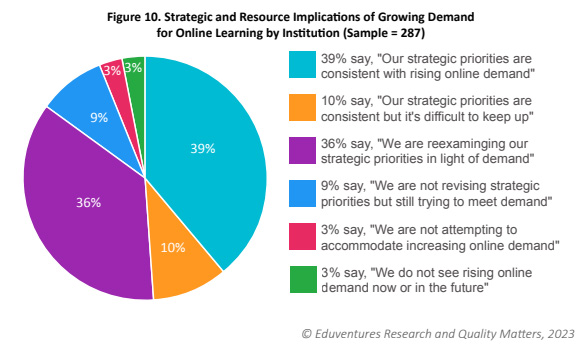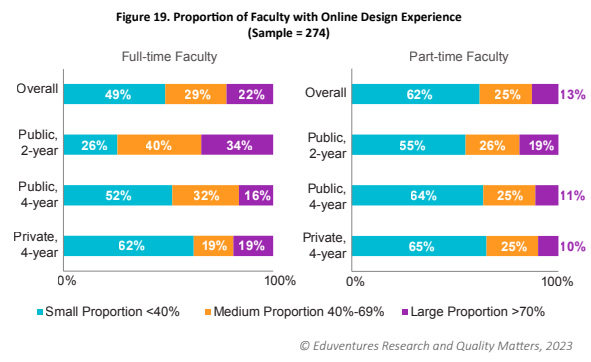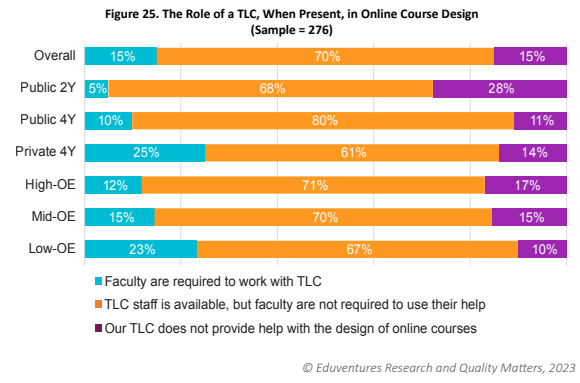enrollment
Course Design Support Is Crucial to Meet the Growing Demand for Online Learning
Every year, I look forward to the release of the Changing Landscape of Online Education (CHLOE) report from QM and Eduventures, which shares results from a national survey of chief online officers (COOs) across higher education. This year’s installment, CHLOE 8, highlights an interesting confluence of the continued growth of online learning and the ways in which institutions are poised to respond to changing student preferences. The report has so many nuggets worth digging into; I’ll highlight a few here and will share some other CHLOE 8 insights in an upcoming blog post focused on online course quality measures.
Student demand continues to shift online
The headline findings from this report center around the demand for online learning compared to face-to-face courses, as illustrated by enrollment shifts. Several key figures illustrate this point:
- Continuing student interest and corresponding enrollment growth in fully online programs. While enrollment growth in online programs is less pronounced among traditional-age undergraduates (36% vs. 50.6% for adult undergraduates and 50.6% for graduate students), this figure is still striking. It suggests traditional undergraduate students are less eager to return to traditional on-campus programs and have a greater appetite for fully online or hybrid learning experiences.
- Most on-campus programs face stagnant or declining enrollment across undergraduate and graduate populations. Adult undergraduates lead this trend with enrollment in on-campus programs remaining flat (56.6%) or declining (24.8%). This is unsurprising given shifting adult student preferences for online modalities, even pre-pandemic.
Examining strategic priorities and resources amid resource strain
Intentional investment in infrastructure is necessary to support and scale online programs. Yet, when asked about the strategic implications of the demand for online learning, chief online officers report a wide range of levels of preparedness (see Figure 10): On the one hand, 39 percent said their institution’s priorities were consistent with rising online demand. However, resource strain is likely for the 36 percent who are reexamining strategic priorities, the 9 percent who are trying to meet demand without revising priorities, and the 10 percent who say it’s difficult to keep up.
Course design support is needed to grow online programs
The tension between online growth aspirations and existing resources becomes especially poignant when we consider the support for faculty who design online courses. To remain competitive and attract future online students, 66 percent of surveyed institutions are adding new online programs based on student demand. This begs the question: Which faculty will be involved in designing these online courses and what experience do they have with online course design? An alarmingly small number of respondents reported a high proportion of faculty with online course design experience (22% for full-time faculty and 13% for part-time faculty). This problem is most acute at private 4-year institutions where a majority of COOs (62%) said that only a small proportion of faculty had online course design experience.
Given this disconnect, what training and support is available to faculty when designing online courses? Looking back at CHLOE 7 (2022), 13 percent of COOs rated faculty professional development around course design to be the highest priority, and 40 percent rated it as a high priority for further investment. In that same report, most institutions offered such professional development, but only 34 percent of institutions required it for all faculty. Similarly, this year’s data revealed the varied role of the Teaching and Learning Center (TLC) in online course design. While 75 percent of surveyed institutions have a TLC, only 15 percent of those institutions require faculty to work with the TLC for online course design. Furthermore, 15 percent of COOs said that their TLC did not offer any support for online course design.
While instructional design staff may be available to faculty outside of the TLC, last year’s report pointed to serious concerns. Even following a significant increase in FTE instructional designers from pre-pandemic levels, only 10 percent of COOs felt their ID staffing capacity was completely sufficient to meet current needs, and just 3 percent felt the same about the ability to meet future needs. This data was not available for the 2023 report but given the current and projected increased demand for online learning, this likely remains a significant concern at many institutions.
A way forward
The factors discussed above drive our work with clients. RNL’s Instructional Design With Six Red Marbles emphasizes the value of student engagement as a means of driving enrollment and retention. We also understand the pivotal role faculty play in online program success and therefore course design support for faculty is integrated into our work. Our instructional designers take a faculty-forward approach to collaborative course design and development. This includes a fully-facilitated, evidence-based course design process with embedded professional development training at the point of need.
See how our Instructional Design and Development team can provide the course design expertise and capacity needed to execute your online enrollment growth strategy. Ask for a complimentary consultation and we will discuss how we can help you deliver high quality courses that generate enrollment and increase student success.
Elevate the online learning experience with expert instructional design
RNL’s Instructional Design team is made up of industry experts in education and technology. Talk with us about how you can develop new courses and optimize your current ones to transform your online course offerings into the best of the best.



